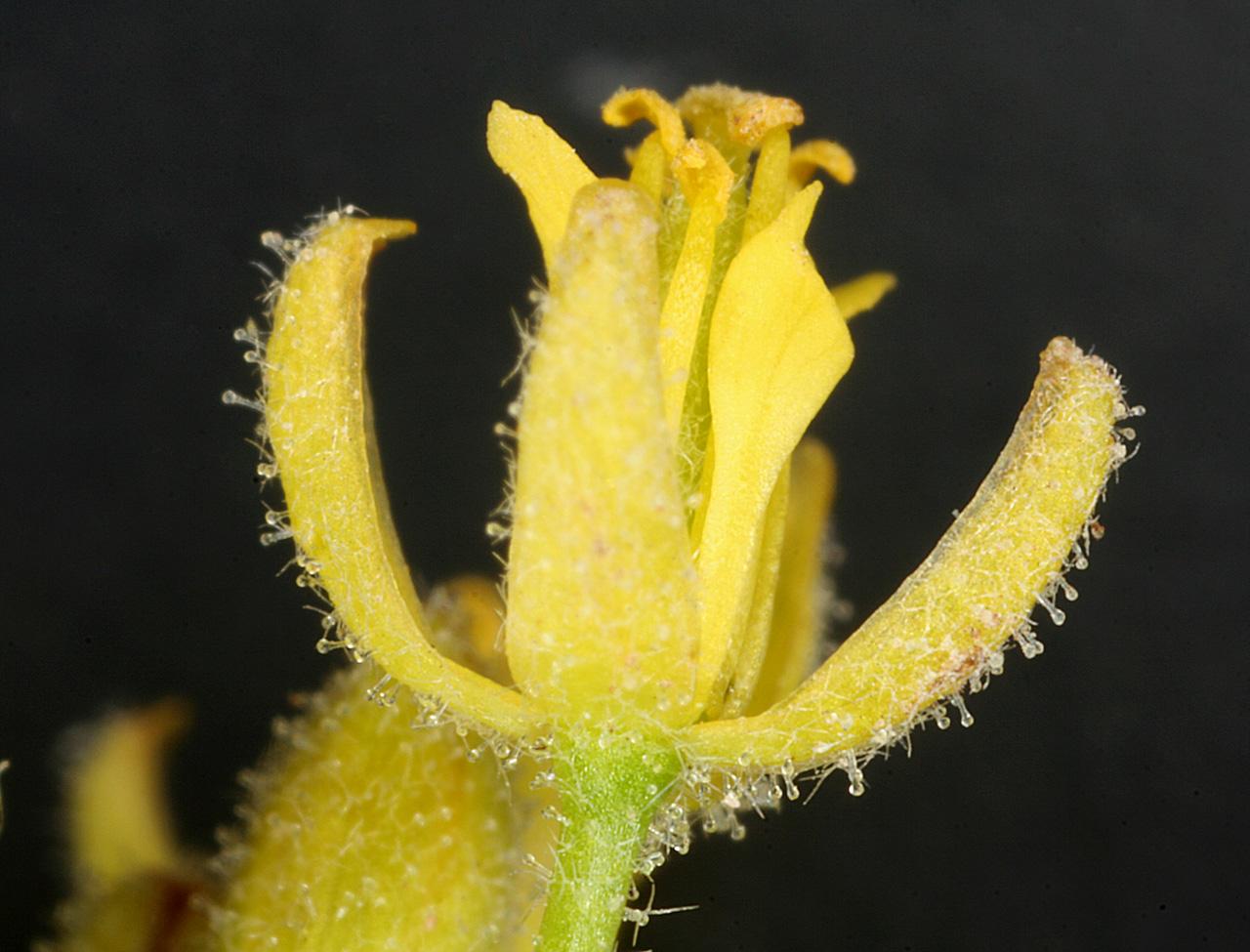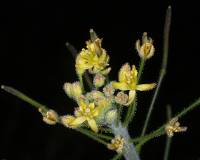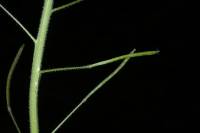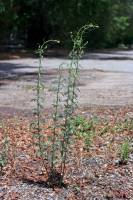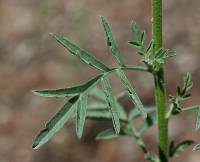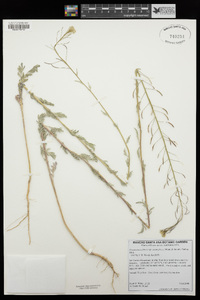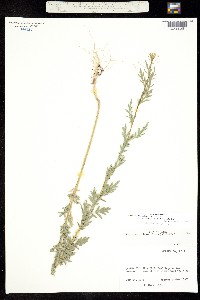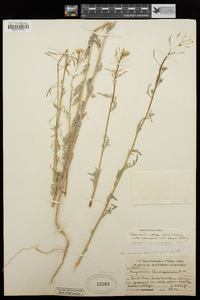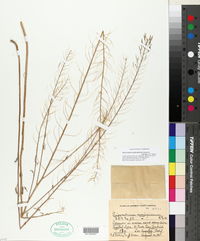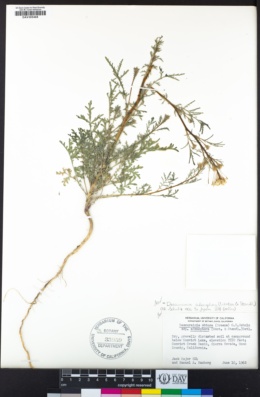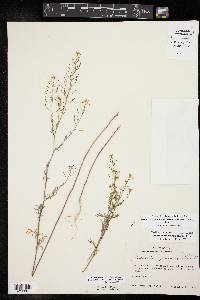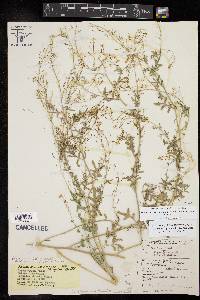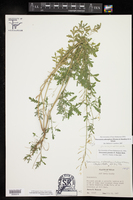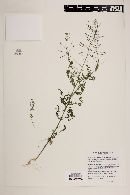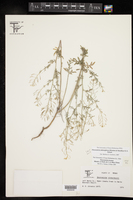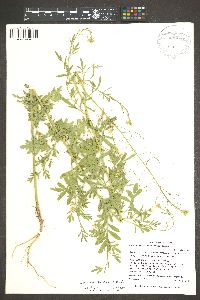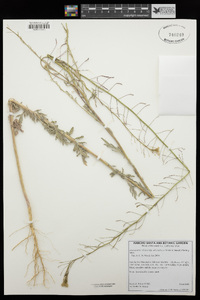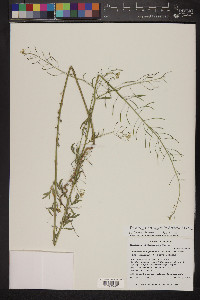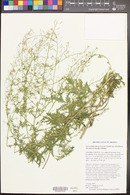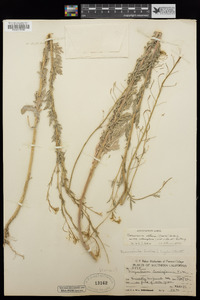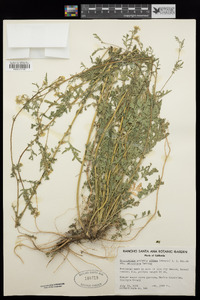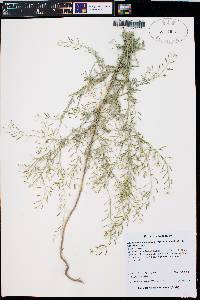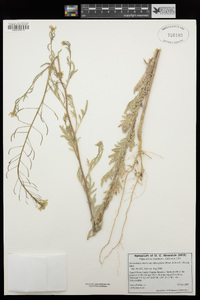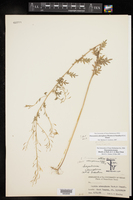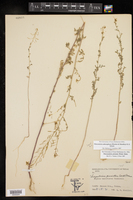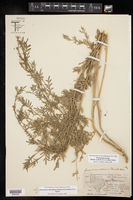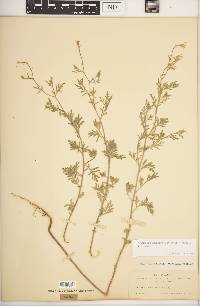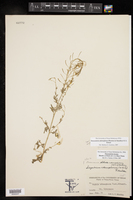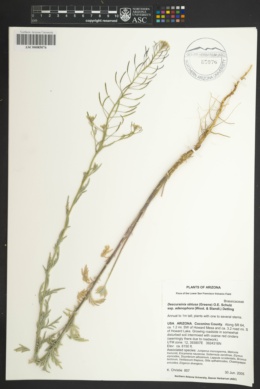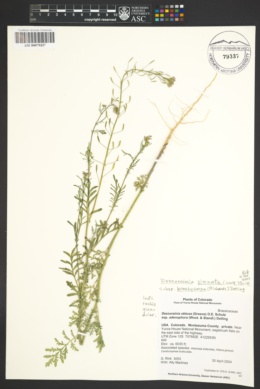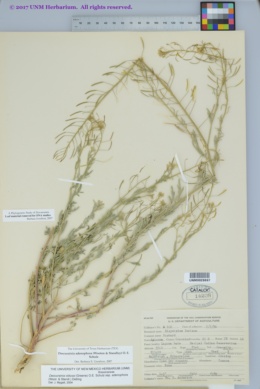Descurainia adenophora
|
|
|
|
Family: Brassicaceae
blunt tansymustard
[Descurainia obtusa subsp. adenophora (Woot. & Standl.) Detling] |
Descurainia obtusa subsp. adenophora is similar to Descurainia obtusa subsp. obtusa. It has small yellow flowers on top of a tall herb with once or twice pinnately divided leaves. However, the inflorescence and much of the herbage is glandular and pubescent and the leaf segments are not as rounded. It is also found at middle elevation. Descurainia obtusa subsp. adenophora can grow to about a meter in height.
Biennials; glandular (at least distally); finely pubescent, often canescent, trichomes dendritic, sometimes mixed with simple ones. Stems erect, unbranched basally, branched distally, 4.5-13 dm. Basal leaves: petiole 1-3 cm; blade pinnate, oblanceolate to obovate or ovate in outline, 2-10 cm, lateral lobes (2-5 pairs), oblanceolate to lanceolate, (4-12 × 1-5 mm), margins entire or serrate to crenate, (apex obtuse). Cauline leaves sessile or shortly petiolate; blade smaller distally, distal lobes often narrower, surfaces densely pubescent. Racemes considerably elongated in fruit. Fruiting pedicels divaricate, straight, 13-31 mm. Flowers: sepals ascending, greenish to yellowish, oblong, 2-2.9 mm, pubescent, (trichomes dendritic, mixed with glandular papillae); petals oblanceolate, 1.8-2.6 × 0.5-0.7 mm; median filaments 1.8-2.4 mm; anthers 0.3-0.5 mm. Fruits divaricate to erect, linear, slightly torulose, 8-16(-20) × 1-1.3 mm, (abruptly acute at both ends); valves each with distinct midvein, (sparsely pubescent or glabrescent); septum not veined; ovules 48-64 per ovary; style 0.1-0.2 mm, glabrous. Seeds biseriate, light brown, ellipsoid, 0.9-1.1 × 0.5-0.6 mm. 2n = 42. Flowering Jun-Aug. Open forests, sandy grounds, gravelly flats, disturbed areas; 1100-2000 m; Ariz., Calif., Nev., N.Mex., Tex.; Mexico (Baja California, Chihuahua, Coahuila). Both L. E. Detling (1939) and R. C. Rollins (1993) treated Descurainia adenophora as a subspecies of D. obtusa, but the differences are so substantial that they should be recognized as distinct species. From the latter, D. adenophora is distinguished by being hexaploid (versus diploid) with densely glandular (versus eglandular) distal parts, longer sepals (2-2.9 versus 1-2 mm) and petals (1.8-2.6 versus 1.2-2 mm), longer fruiting pedicels (13-31 versus 6-15 mm), biseriate (versus uniseriate) seeds, and more ovules (42-64 versus 16-40) per ovary.
FNA 2010, Jepson 2012, Kearney and Peebles 1969, McDougall 1973 Duration: Annual Nativity: Native Lifeform: Forb/Herb General: Herbaceous annuals to biennials, to 45 cm-1.3 m tall, stems erect, unbranching near the base and branching near stem tips, herbage glandular, finely pubescent and often gray or white with short, soft, branching hairs (dendritic trichomes), these sometimes mixed with unbranched ones, plants with pungent, watery sap. Leaves: Alternate, basal and cauline; basal blades 1-2 pinnate, oblanceolate to obovate or ovate in outline, 2-10 cm long, with 2-5 pairs of oblanceolate to lanceolate lateral lobes, these 4-12 mm long and 1-5 mm wide, margins entire or serrate to crenate, apices acute, blades borne on petioles 1-3 cm long, cauline leaves sessile or on short petioles, blades becoming reduced with narrower distal lobes as one moves up the stems, surfaces densely pubescent. Flowers: Small and yellow with 4 petals forming a cross shape, petals oblanceolate, 1.5-2.5 mm long and 0.5-1 mm wide, sepals ascending, greenish to yellowish, oblong, 2-3 mm, pubescent with dendritic trichomes mixed with glandular nodules (papillae), stamens 6 with 4 long and 2 short, ovary solitary and superior, 1, generally 2-chambered with a septum connecting 2 parietal placentas, styles solitary and glabrous, 0.1-0.2 mm long, stigmas entire or 2-lobed, median filaments 1.5-2.5 mm long, anthers to 0.5 mm long, ovules 48-64 per ovary, flowers borne in elongated racemes, becoming even more elongated in fruit. Fruits: Cylindrical siliques dehiscent into 2 valves and a septum, spreading to erect, linear, slightly twisting (torulose), 8-20 mm long and 1-1.3 mm wide, abruptly acute at both ends, each valve with a distinct midvein, outer surfaces sparsely pubescent or glab Ecology: Found on sandy and gravelly soils, on flats, in open forests and woodlands, lakesides, and disturbed areas, from 3,000-6,500 ft (914-1981 m); flowering May-August. Distribution: Arizona, California, Nevada, New Mexico, Texas; Mexico. Ethnobotany: Specific uses for this species are unknown, but other species in the genus have uses; plants cooked and eaten in the spring, seeds ground and added to water to make a refreshing, summer drink, parched, ground, kneaded into seed butter and eaten with fruit drinks or spread on bread or ground into a flour, also plants moistened, steamed, liquid squeezed and the remaining mass used as paint to decorate pottery. Etymology: Descurainia is named in honor of Francois Descourain (1658-1740), a French pharmacist and botanist, and adenophora means bearing or producing glands as some part of the plant, often referring to sticky glands. Synonyms: Descurainia obtusa subsp. adenophora Editor: LCrumbacher2012 |

